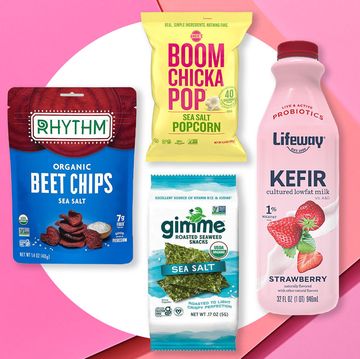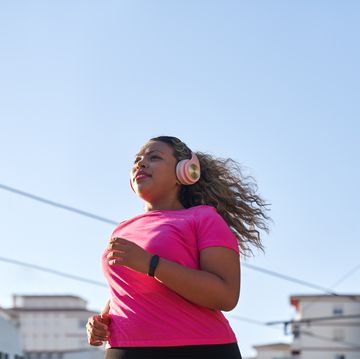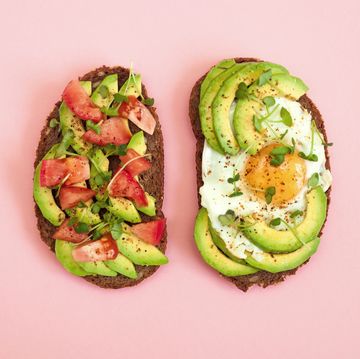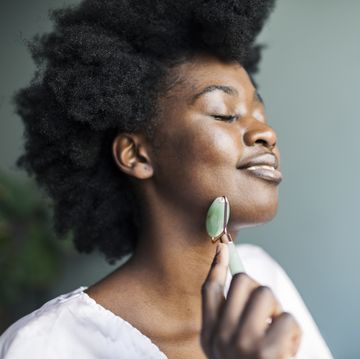You know there are good carbs and bad carbs, but it can be pretty damn hard to tell them apart. That's where the glycemic index comes into play—and it might just be your key to losing weight by cutting carbs the healthy way.
“The glycemic index is a value that is given to a food based on how quickly or slowly that particular food will increase blood sugar levels,” says Alix Turoff, R.D., a nutritionist and certified personal trainer with a virtual private practice. Plenty of resources exist listing the glycemic index for hundreds of foods (more on that later) so you don't even have to worry about calculating it on your own, either.
So how exactly can low glycemic foods help you lose weight? Quick bio lesson: All carbohydrates are eventually broken down into sugar, also known as glucose, but the more complex the carbohydrate, the more steps it has to go through in the body to become a sugar molecule and then be released into your blood to provide fuel for your body and brain.
Foods low on the glycemic index (GI) scale—most non-starchy vegetables, beans, and fruits like chickpeas, apples, and berries—are typically more complex, and since it takes longer to convert these to glucose, the sugar is released into your blood slower and more steadily, Turoff explains, which is better for weight loss. On the other hand, if a food is high on the glycemic index scale, like white bread or Gatorade, the molecule make up of the food is pretty close to sugar already, so your body doesn’t have to do much work and it releases the sugar quickly, causing your blood sugar to spike, which can adversely affect your weight-loss goals.
Low-glycemic diets can be great for diabetics, but even if you don't fall in that category, it could still help you eat healthier. Here's everything you need to know:
Related: 7 Sneaky Signs Your Blood Sugar Is Too High
While following the glycemic index will help you choose healthier carbs to add to your diet, what you really want to focus on is the glycemic load of the foods you eat. Glycemic load is simply the glycemic index multiplied by the grams of carbohydrates in a food, Turoff says. “The glycemic load offers a more accurate depiction of what would happen to your blood sugar if you actually ate the food, since fiber affects how quickly the sugar is released into your bloodstream and, therefore, how much of a spike in blood sugar you’re looking at.”
The conversion formula looks like this: Glycemic load = Glycemic Index x Grams of Carbs / 100
An easier method: Skip the math and use an app like the Low GI Diet Tracker or Glycemic Index & Load of Food For Low Carb Diets.
You want foods with a glycemic load around 10 or less, but definitely under 20, which is the threshold for “high,” she says.
Why is glycemic load a more accurate weight-loss tool than the glycemic index? Take brown rice and quinoa: One serving of brown rice has a GI of 50 with 32 grams of carbs, so its glycemic load is 16; quinoa, meanwhile, has a GI of 53 with 25g grams of carbs, so a glycemic load of 13. “Looking at just the glycemic index, it seems like quinoa will cause a higher blood sugar spike, but quinoa actually has a lower glycemic load than brown rice once carbs are factored in, so it’s actually easier on your blood sugar,” Turoff explains. “Glycemic index doesn’t tell the whole story.”
Related: 3 Signs You Need To Start Eating More Carbs
The American Diabetes Association recommends diabetics focus on eating high-fiber, non-starchy vegetables and whole grains, and avoid processed flours and sugar—all of which falls under a diet low on the glycemic index. "It’s a great eating plan for diabetics since they don’t produce enough insulin to break down the low-GI carbs, doubling up on the high blood sugar," Turoff explains.
Plus, while diabetics are at an increased risk of certain diseases, including heart disease, a recent study in Nutrients found eating carbs rich in fiber with a low glycemic index or low glycemic load can offset the high triglyceride levels and low good cholesterol levels that may contribute to this risk.
Check out some of the weirdest weight-loss trends through history:
Spikes in blood sugar not only cause your energy to peak and then crash, but will also leave you feeling hungry shortly after a meal, Turoff says. Plus, eating high glycemic foods often over time can increase your risk for certain diseases, including colon and bladder cancer and stroke.
And the diet plan will help you eat cleaner. “Following a low glycemic load is a good way to eat because it focuses on complex carbohydrates with more fiber and eschews processed and refined carbs and simple sugars,” she adds.
Related: Spending 15 Minutes Doing This After Dinner Can Help You Drop Pounds
While it will help you eat cleaner foods, following a low-glycemic diet probably won’t help you lose any more weight than your typical diet would. One study in Obesity found that a low-GI diet didn't help obese adults lose any more fat or affect their metabolism any more than a high-GI or high-carb diet when caloric and fiber intake were matched (though both groups saw improvements).
Also, focusing solely on glycemic load still misses part of the story: “It does focus on eating high-fiber carbs which will keep you full and your energy levels consistent. But the glycemic load doesn’t focus on fat or protein, and if weight loss is a goal, it’s important to also control intake of these other macronutrients,” Turoff adds. (Learn how to blast fat and tone your entire body with the Women's Health Guide to Strength Training!)
Since it highlights healthy carbs, a low glycemic-load diet is pretty much the basis for most popular diets, and a great way to eat cleaner, Turoff says.
To keep your eye on balance all around, Turoff suggests determining your macro goals and having the majority of your carb intake come from foods with a low glycemic load.
The one group it’s probably not right for: Endurance athletes like runners, swimmers, and cyclists because they need more carbs and that instant energy to fuel their workouts, she adds.

Rachael Schultz is a freelance writer who focuses primarily on why our bodies and brains work the way they do, and how we can optimize both (without losing our sanity). She’s most passionate about hiking, traveling, mindfulness, cooking, and really, really good coffee.




